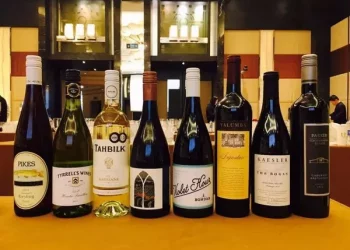Australia is one of the outstanding representatives of the New World wine producing countries.
Australia is well placed to be a wine producer.
Due to the large area and sparse population, many places in Australia have not been polluted by manual operation, and the original state has been well preserved, which creates ideal conditions for the healthy growth of grapes. Therefore, a lot of excellent quality and world-renowned wines have been produced.
Australia now has more than 2,000 wineries, mostly small, family-owned wineries, but also supersized wineries such as Foster’s wine Group and Casella Wines, which together produce two-thirds of the country’s wine.
Australia’s most famous grape variety is the Shiraz (known as Shiraz in Australia), the most widely grown grape variety in Australia.
It now accounts for 40% of Australia’s red grape cultivar and 20% of the country’s total grape acreage.
Shiraz and Syrah are essentially the same grape varieties, called differently in different regions, but the wines they produce are very different in style.
Syrah grapes are very similar to Cabernet Sauvignon grapes, with small, thick-skinned, dark fruits that often fail to ripen fully in cold regions.
Wines made from syrah grapes are dark, medium tannins and acidity, full-bodied, often with dark fruit (e.g., BLACKBERRY) and dark chocolate flavours.
Syrah wines from milder regions may also be flavored with herbs (such as mint), smoked meats and spices (black pepper).
Syrah wines from hotter climates, on the other hand, tend to show more sweet spices (liquorice, cloves) and develop subtle animal and vegetable flavors as they age.
Australian Syrah wines are sweet and ripe, with more chocolate flavours than the Rhone Valley Syrah, rather than the usual pepper and spice flavours.
Australia now has 60 producing regions and more than 100 geographical indication names.
South Australia produces the most alcohol in Australia, accounting for half of the country’s total output.
1. Barossa Valley, one of Australia’s oldest wine regions, is located about 56 kilometers northeast of the city of Adelaide.
The Barossa Valley is known for its rich AND powerful syrah wines, which are dark red and full-bodied, with BLACKBERRY and licorice aromas and intense chocolate flavours.
The region also produces luxury Cabernet Sauvignon, full-bodied Semillon and Chardonnay.
Most of Australia’s big wineries are in this region, such as Penfolds.
2. Clare Valley is located in the northern part of the Lofti Mountains, 130 km north of Adelaide City, and only 1 hour’s drive from Barossa Valley.
Clare Valley produces dry riesling wines.
3. Vale, in the heart of the Fleurieu region, is known for its soft, full-bodied red wines.
Mellalenville is a green and fresh region that grows syrah, Fiano, Tempranillo, Sangiovese, Zinfandel, Touriga and Barbera.
4. The Adelaide Hills production area is located around the city of Adelaide, which is a part of the Lofti Mountains.
The mountains of Adelaide produce wines that are generally vibrant, elegant and fresh with acidity, and are renowned for their top Sauvignon Blanc, Chardonnay and Pinot Noir monophones and sparkling wines.
5. Coonawarra, located in Limestone Coast area of South Australia, is famous for producing a single variety of Cabernet Sauvignon wine.
In addition to cabernet sauvignon, Coonawarra grows syrah, riesling and grapes such as Merlot, Malbec and Petit Verdot.
6. The Hunter Valley is the most famous and acclaimed wine region in New South Wales, Australia.
The region specializes in Semillon and Syrah wines.
In contrast to Old World wine labels in Europe, Australian wine labels are clear and easy to understand. The most important feature of Australian wine labels is that they indicate “grape variety” and “region”.
The main information on the wine label includes the Winery, the Winery/Trade Mark, and the Vintage.
At least 85% of the grapes are picked from that year, the Grape Varieties, Geographical Indication, Volume, Country of Origin and Alcohol concentration of the grape
The Content).
It is important to note that Australian regulations do not restrict the variety of grapes used to make wine, nor do they mandate the labeling of grape varieties.
However, if the grape variety is to be labeled, the following provisions must be followed: 1. If a single grape variety is labeled, the proportion of the variety used shall be at least 85%; 2.
2. For blended wines, no more than 5 varieties shall be labeled, and the number of varieties shall exceed 95% of the whole and the proportion of single varieties shall be at least 5%;
3. A maximum of 3 varieties shall be labeled, the proportion of total varieties shall exceed 85%, and the proportion of single varieties shall be at least 20%.
In addition, Australian regulations do not mandate labeling of grape regions and wineries.
But if a single grape region is designated, at least 85 percent of the grapes used to make wine come from that region.
In the case of blended wines, no more than three regions shall be identified and at least 95% of the grapes used in the wine shall be from the regions indicated, with at least 5% of the grapes from a single region.
Australia has strict rules on the content of wine labels, which do not allow any false and misleading information about the origin of grapes, and many names (i.e. the names of geographical indications) are protected by law.
Generally speaking, the higher the value of a top wine, the smaller the grape region.
The latest market dynamics at any time to see, please pay attention to.












































